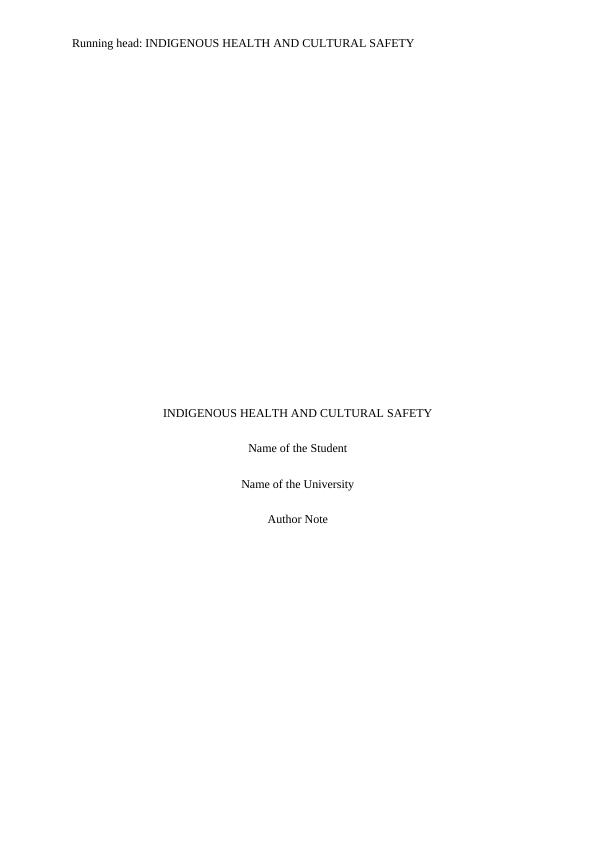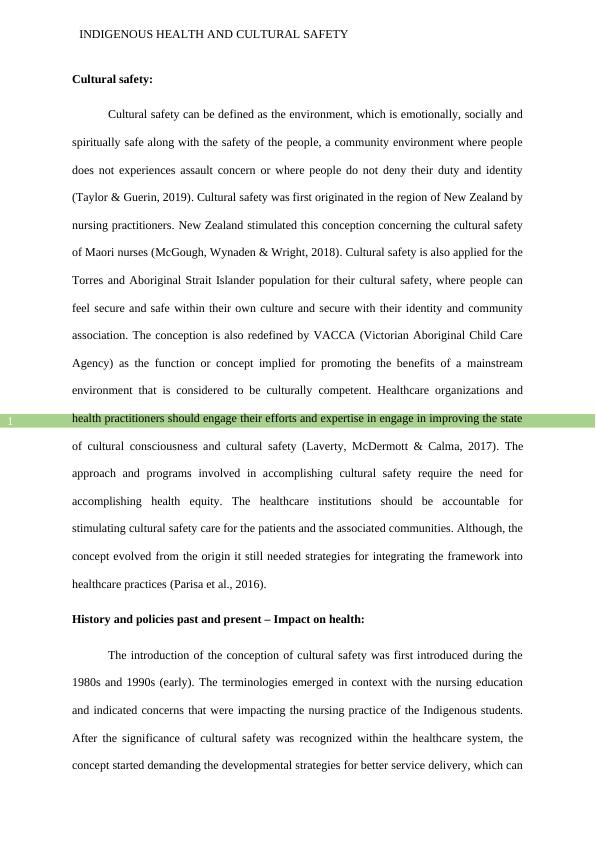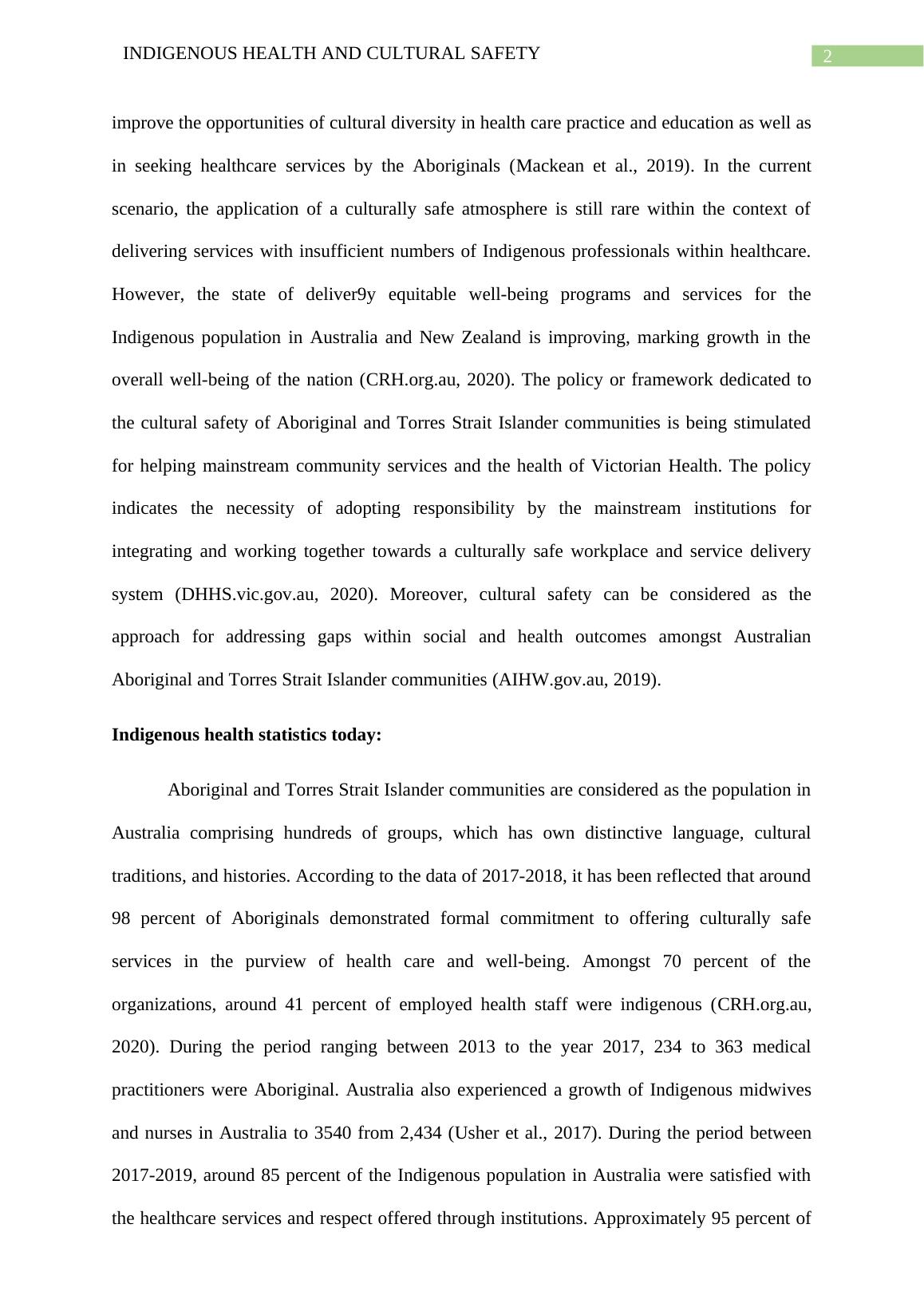Assignment about Indigenous Health and Cultural Safety
Added on 2022-09-14
7 Pages1575 Words12 Views
Running head: INDIGENOUS HEALTH AND CULTURAL SAFETY
INDIGENOUS HEALTH AND CULTURAL SAFETY
Name of the Student
Name of the University
Author Note
INDIGENOUS HEALTH AND CULTURAL SAFETY
Name of the Student
Name of the University
Author Note

INDIGENOUS HEALTH AND CULTURAL SAFETY
1
Cultural safety:
Cultural safety can be defined as the environment, which is emotionally, socially and
spiritually safe along with the safety of the people, a community environment where people
does not experiences assault concern or where people do not deny their duty and identity
(Taylor & Guerin, 2019). Cultural safety was first originated in the region of New Zealand by
nursing practitioners. New Zealand stimulated this conception concerning the cultural safety
of Maori nurses (McGough, Wynaden & Wright, 2018). Cultural safety is also applied for the
Torres and Aboriginal Strait Islander population for their cultural safety, where people can
feel secure and safe within their own culture and secure with their identity and community
association. The conception is also redefined by VACCA (Victorian Aboriginal Child Care
Agency) as the function or concept implied for promoting the benefits of a mainstream
environment that is considered to be culturally competent. Healthcare organizations and
health practitioners should engage their efforts and expertise in engage in improving the state
of cultural consciousness and cultural safety (Laverty, McDermott & Calma, 2017). The
approach and programs involved in accomplishing cultural safety require the need for
accomplishing health equity. The healthcare institutions should be accountable for
stimulating cultural safety care for the patients and the associated communities. Although, the
concept evolved from the origin it still needed strategies for integrating the framework into
healthcare practices (Parisa et al., 2016).
History and policies past and present – Impact on health:
The introduction of the conception of cultural safety was first introduced during the
1980s and 1990s (early). The terminologies emerged in context with the nursing education
and indicated concerns that were impacting the nursing practice of the Indigenous students.
After the significance of cultural safety was recognized within the healthcare system, the
concept started demanding the developmental strategies for better service delivery, which can
1
Cultural safety:
Cultural safety can be defined as the environment, which is emotionally, socially and
spiritually safe along with the safety of the people, a community environment where people
does not experiences assault concern or where people do not deny their duty and identity
(Taylor & Guerin, 2019). Cultural safety was first originated in the region of New Zealand by
nursing practitioners. New Zealand stimulated this conception concerning the cultural safety
of Maori nurses (McGough, Wynaden & Wright, 2018). Cultural safety is also applied for the
Torres and Aboriginal Strait Islander population for their cultural safety, where people can
feel secure and safe within their own culture and secure with their identity and community
association. The conception is also redefined by VACCA (Victorian Aboriginal Child Care
Agency) as the function or concept implied for promoting the benefits of a mainstream
environment that is considered to be culturally competent. Healthcare organizations and
health practitioners should engage their efforts and expertise in engage in improving the state
of cultural consciousness and cultural safety (Laverty, McDermott & Calma, 2017). The
approach and programs involved in accomplishing cultural safety require the need for
accomplishing health equity. The healthcare institutions should be accountable for
stimulating cultural safety care for the patients and the associated communities. Although, the
concept evolved from the origin it still needed strategies for integrating the framework into
healthcare practices (Parisa et al., 2016).
History and policies past and present – Impact on health:
The introduction of the conception of cultural safety was first introduced during the
1980s and 1990s (early). The terminologies emerged in context with the nursing education
and indicated concerns that were impacting the nursing practice of the Indigenous students.
After the significance of cultural safety was recognized within the healthcare system, the
concept started demanding the developmental strategies for better service delivery, which can

INDIGENOUS HEALTH AND CULTURAL SAFETY
2
improve the opportunities of cultural diversity in health care practice and education as well as
in seeking healthcare services by the Aboriginals (Mackean et al., 2019). In the current
scenario, the application of a culturally safe atmosphere is still rare within the context of
delivering services with insufficient numbers of Indigenous professionals within healthcare.
However, the state of deliver9y equitable well-being programs and services for the
Indigenous population in Australia and New Zealand is improving, marking growth in the
overall well-being of the nation (CRH.org.au, 2020). The policy or framework dedicated to
the cultural safety of Aboriginal and Torres Strait Islander communities is being stimulated
for helping mainstream community services and the health of Victorian Health. The policy
indicates the necessity of adopting responsibility by the mainstream institutions for
integrating and working together towards a culturally safe workplace and service delivery
system (DHHS.vic.gov.au, 2020). Moreover, cultural safety can be considered as the
approach for addressing gaps within social and health outcomes amongst Australian
Aboriginal and Torres Strait Islander communities (AIHW.gov.au, 2019).
Indigenous health statistics today:
Aboriginal and Torres Strait Islander communities are considered as the population in
Australia comprising hundreds of groups, which has own distinctive language, cultural
traditions, and histories. According to the data of 2017-2018, it has been reflected that around
98 percent of Aboriginals demonstrated formal commitment to offering culturally safe
services in the purview of health care and well-being. Amongst 70 percent of the
organizations, around 41 percent of employed health staff were indigenous (CRH.org.au,
2020). During the period ranging between 2013 to the year 2017, 234 to 363 medical
practitioners were Aboriginal. Australia also experienced a growth of Indigenous midwives
and nurses in Australia to 3540 from 2,434 (Usher et al., 2017). During the period between
2017-2019, around 85 percent of the Indigenous population in Australia were satisfied with
the healthcare services and respect offered through institutions. Approximately 95 percent of
2
improve the opportunities of cultural diversity in health care practice and education as well as
in seeking healthcare services by the Aboriginals (Mackean et al., 2019). In the current
scenario, the application of a culturally safe atmosphere is still rare within the context of
delivering services with insufficient numbers of Indigenous professionals within healthcare.
However, the state of deliver9y equitable well-being programs and services for the
Indigenous population in Australia and New Zealand is improving, marking growth in the
overall well-being of the nation (CRH.org.au, 2020). The policy or framework dedicated to
the cultural safety of Aboriginal and Torres Strait Islander communities is being stimulated
for helping mainstream community services and the health of Victorian Health. The policy
indicates the necessity of adopting responsibility by the mainstream institutions for
integrating and working together towards a culturally safe workplace and service delivery
system (DHHS.vic.gov.au, 2020). Moreover, cultural safety can be considered as the
approach for addressing gaps within social and health outcomes amongst Australian
Aboriginal and Torres Strait Islander communities (AIHW.gov.au, 2019).
Indigenous health statistics today:
Aboriginal and Torres Strait Islander communities are considered as the population in
Australia comprising hundreds of groups, which has own distinctive language, cultural
traditions, and histories. According to the data of 2017-2018, it has been reflected that around
98 percent of Aboriginals demonstrated formal commitment to offering culturally safe
services in the purview of health care and well-being. Amongst 70 percent of the
organizations, around 41 percent of employed health staff were indigenous (CRH.org.au,
2020). During the period ranging between 2013 to the year 2017, 234 to 363 medical
practitioners were Aboriginal. Australia also experienced a growth of Indigenous midwives
and nurses in Australia to 3540 from 2,434 (Usher et al., 2017). During the period between
2017-2019, around 85 percent of the Indigenous population in Australia were satisfied with
the healthcare services and respect offered through institutions. Approximately 95 percent of

End of preview
Want to access all the pages? Upload your documents or become a member.
Related Documents
Culturally Safe Health Care for the Indigenous Peoplelg...
|18
|907
|27
Communication and Diversity in Healthcare: Culturally Safe and Respectful Nursing for Aboriginals in Australialg...
|6
|1778
|38
Cultural Safety in Healthcarelg...
|8
|2356
|201
Nursing Assignment: Perception Analysislg...
|8
|1948
|85
Aboriginal and Torres Strait Islanders’ Wellbeinglg...
|10
|2766
|395
Cultural Competence in Nursinglg...
|11
|2933
|184
